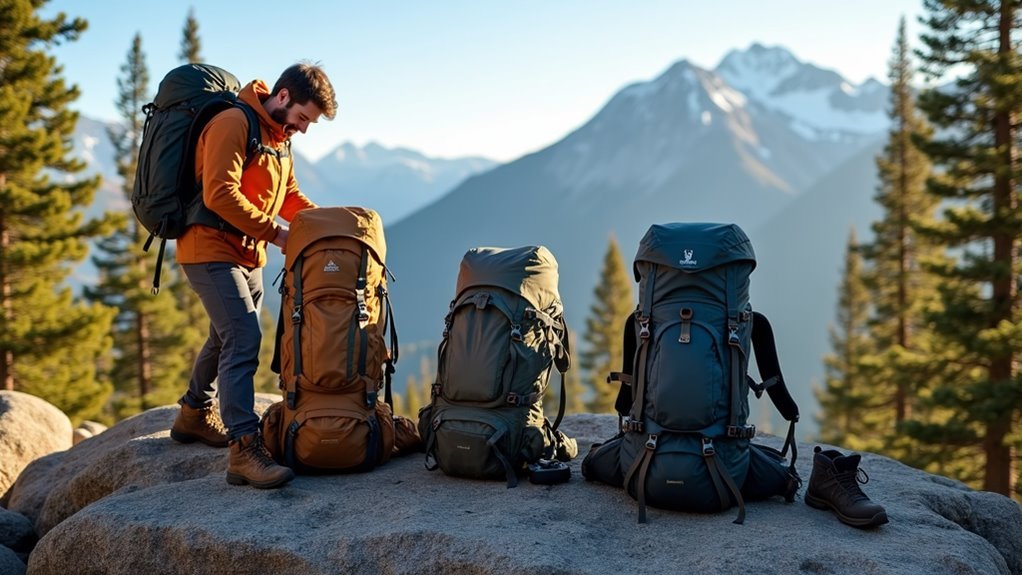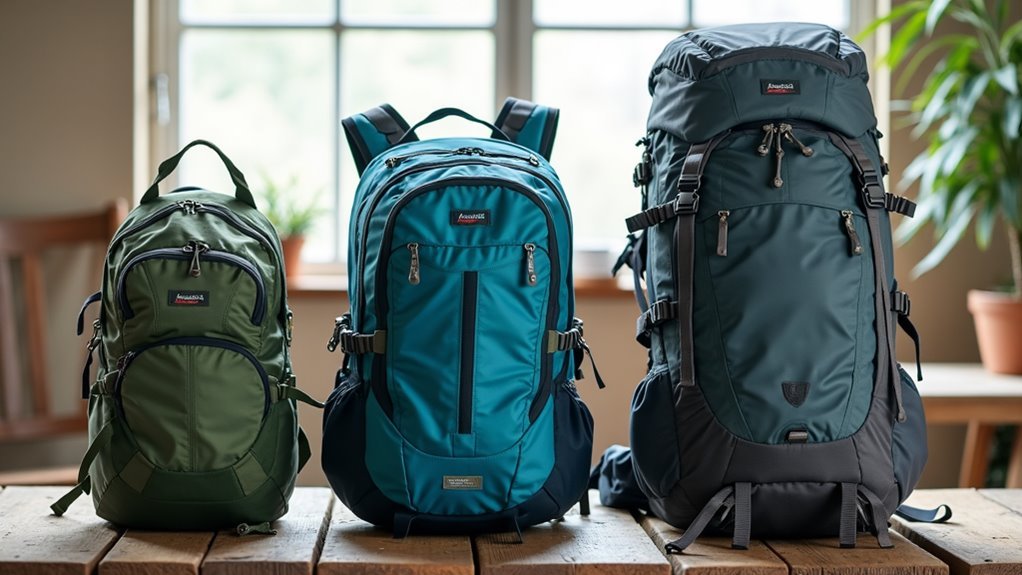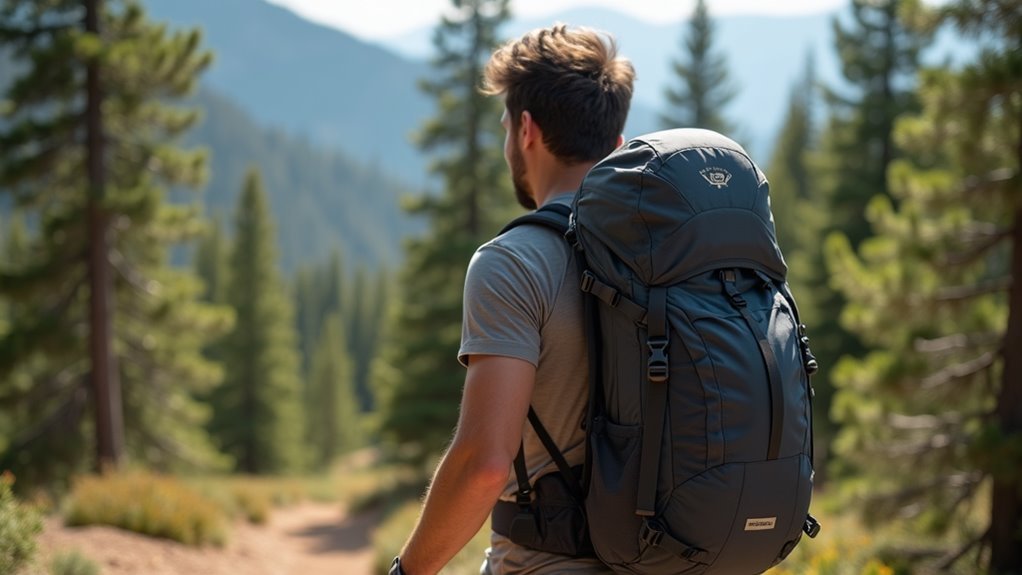I think choosing the right backpack starts with honest self-assessment—perhaps you’re really commuting daily rather than scaling mountains. Consider your actual activities and select appropriate capacity: 25-35L works for school or day trips, while 40-50L suits weekend adventures. I’d prioritize durable materials like Cordura for tough use or lighter nylon for casual needs. Don’t overlook comfort features like padded straps and proper torso fit, since these details make all the difference when you’re carrying everything you need.
Assess Your Specific Needs and Intended Use

Why do so many people end up with the wrong backpack gathering dust in their closet?
I think it’s because they skip this vital first step—honestly evaluating what they actually need.
Before you get swept away by flashy features or trendy designs, pause.
Are you hitting the trails every weekend, or do you need something for daily commutes?
Ask yourself the hard question: what will you actually use this backpack for on a typical Tuesday?
Maybe you’re planning that backpacking trip across Europe you’ve been dreaming about for years.
Your lifestyle dictates everything.
A gym bag won’t cut it for multi-day hikes, and perhaps that massive hiking pack feels ridiculous on city streets.
Be honest about your reality, not your aspirations.
Understand Backpack Types and Their Unique Features
Once you’ve figured out what you actually need, the sheer variety of backpack types might feel overwhelming—and honestly, it kind of is.
There’s hiking backpacks built for rugged terrain, laptop backpacks with specialized compartments, and gym bags made from breathable materials. I think anti-theft models are clever with their hidden zippers, though perhaps overkill for most situations.
Army backpacks offer tactical features but might look too serious for everyday use.
The thing is, many backpacks blur these lines—a good hiking pack can work for travel, and laptop bags often handle school supplies fine.
Don’t get too caught up in perfect categorization.
Select the Right Size and Capacity for Your Activities

Most backpacks range from 25 to 75 liters, though I’ll be honest—those numbers don’t mean much until you start actually using them.
Here’s what I’ve learned works for different activities:
After years of trial and error, these capacity ranges actually make sense in real-world situations.
- Day trips and school: 25-35L handles books, lunch, maybe a jacket
- Weekend getaways: 40-50L fits clothes for 2-3 days without overpacking
- Week-long adventures: 55-65L gives you room for everything, perhaps even too much
- Extended travel: 65-75L for those who can’t pack light (no judgment here)
- Gym sessions: 20-30L keeps it simple with shoes and gear
I think 55L hits that sweet spot for most people’s freedom-seeking adventures.
Choose Durable Materials That Match Your Environment
Since you’ll probably be throwing your backpack into car trunks, dragging it across airport floors, and maybe even through some unexpected weather, the material choice matters more than I initially thought when I started researching this stuff.
| Material | Best For | Freedom Factor |
|---|---|---|
| Cordura | Adventure seekers | Lets you explore without worry |
| Rip Stop Nylon | Outdoor enthusiasts | Won’t hold you back on trails |
| PVC Fabric | Urban nomads | Handles city chaos effortlessly |
| Polyester Pack Cloth | Sun chasers | Resists UV damage during travels |
| Standard Nylon | Budget travelers | Basic protection for light adventures |
I think the right material basically gives you permission to stop babying your gear and just go live.
Prioritize Ergonomic Design and Comfort Features

When you’re hauling around everything from laptops to camping gear, your back and shoulders are basically doing unpaid labor for hours at a time.
I think investing in proper ergonomic features isn’t just smart—it’s essential for your freedom to move without pain.
Look for these comfort-focused elements:
- Padded shoulder straps that distribute weight evenly
- Lumbar support and hip belts for longer carries
- Adjustable stabilizer straps to balance heavy loads
- Breathable back panels to prevent sweating
- Proper fit sizing that matches your torso length
Perhaps most importantly, remember that even the best ergonomic design won’t help if you’re exceeding that 25% body weight recommendation.
Master Proper Maintenance and Care Techniques
After spending good money on the right backpack, you’ll want it to last more than a semester or two—and honestly, I’ve learned this lesson the hard way with a few packs that could’ve survived much longer with better care.
Regular cleaning makes a huge difference, though I’ll admit I’m not always consistent about it. Most backpacks handle gentle machine washing, but check the label first. Air drying prevents material breakdown that heat can cause.
Perhaps most importantly, don’t stuff your pack beyond capacity. I think proper weight distribution and avoiding sharp objects will prevent those annoying tears that seem to appear overnight.
Frequently Asked Questions
What Is the Average Lifespan of a Quality Backpack With Regular Use?
I’ve found that quality backpacks typically last 5-10 years with regular use. However, I’d recommend you consider factors like material durability, usage frequency, and maintenance habits since they’ll greatly impact your pack’s actual lifespan.
Can I Take My Backpack as Carry-On Luggage on Flights?
Most airlines allow backpacks under 22x14x9 inches as carry-on. I’d recommend checking your airline’s specific size limits before traveling. Your freedom to explore depends on packing smart and staying within those dimensional restrictions for hassle-free boarding.
How Much Should I Expect to Spend on a Good Backpack?
You’ll find quality backpacks ranging from $50-200 depending on your needs. I’d invest $80-120 for versatile everyday use, while specialized hiking or anti-theft models might cost more. Don’t overspend – focus on features that matter for your adventures.
Are There Backpacks Specifically Designed for Left-Handed People?
I haven’t found backpacks specifically designed for left-handed people. Most backpacks feature symmetrical designs with adjustable straps and compartments that work equally well for both left-handed and right-handed users.
What’s the Difference Between Men’s and Women’s Backpack Designs?
Apparently, women’s torsos are shorter and hips wider than men’s, so their backpacks feature adjusted strap placement and narrower shoulder straps. I’d say choose what fits your body, not marketing labels.
Conclusion
Finding your perfect backpack isn’t rocket science, but it’s definitely worth the effort. I think the key is being honest about what you actually need—not what you think looks cool. Your back will thank you for choosing comfort over style, though perhaps you’ll find both. Remember, a well-chosen backpack becomes your faithful companion, carrying not just your stuff but your adventures too. Don’t rush this decision.